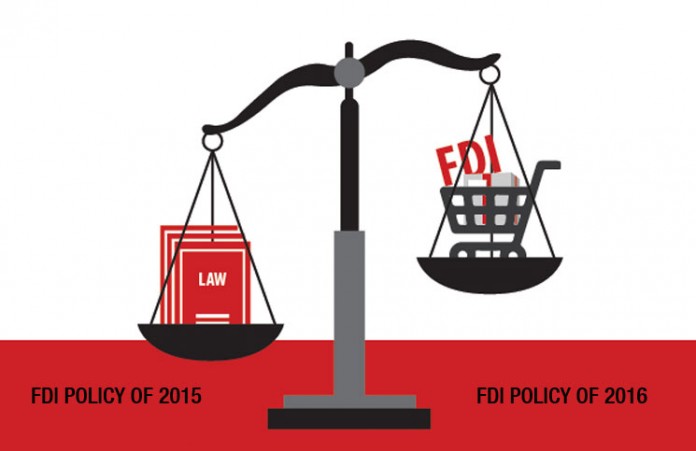n this blog post, Devyani Pokhriyal, a recent Law Graduate and a student pursuing her Diploma in Entrepreneurship Administration and Business Laws from NUJS, Kolkata, compares and contrasts the FDI Policy of 2015 and the FDI Policy of 2016.
Before I go dwell into the above topic would like to discuss what FDI is exactly about and how this policy serves a benefit for the country in a nutshell. In layman’s term, FDI can be described as the direct investment in the business by an investor from another country for which that investor has the control over the company that he has purchased. In this context, the term “owned” is defined by Organization for Economic Corporation and Development (OCED) as owning 10% or more of the business. And in turn, the businesses which make this “Foreign Direct Investment” are often come to be known as the Multinational Corporations (MNCs).[1]
Some of the Major Advantages of these Foreign Direct Investments to the country are:
- The Country can have access to global markets.
- The country has indirect, or direct can have access to the resources of the investing company.
- The cost of production is reduced by a considerable amount which in turn reduces the duties imposed upon the products.
Amendments
The government of India made changes in the Foreign Direct Policy of India on 20th June 2016. This is considered to be a second biggest reform in FDI since its announcement in November of 2015. The NDA government termed this change as the “radical liberalism” of existing FDI policy. The new Policy eases norms for sectors like defence, civil aviation and Parma companies and opens them completely for the foreign investors. The changes have been implemented with the goal of making India more “Investor Friendly” and more so, an attractive FDI destination. For example, the changes in the policy include allowing 100 percent investments from foreign companies under the government approval for things like trading, including through e-commerce, and also in respect of food products manufactured in India[2].
Also to attract more foreign investors in the defence field, the NDA government has removed the condition of the “state of art” technology, and also gave permission to the foreign investors in terms of manufacturing small arms and ammunitions.
Moreover, in order to improve and connect India to the global telecom services, the permission of 100% FDI through automatic route in broadcasting carriage services such as teleports, D-T-H services and mobile tv have also been provided. This is a significant reformation as the government has also allowed 100% FDI in airlines and have given relation in the norms regarding overseas investments in brownfield airports. And also, in the private security agencies, the government has now allowed up to 74% FDI limit as compared to the 49% in 2015[3].
In the matters of single-brand retail trading, the government said that the former local sourcing norm for the foreign firms would not be applicable for not more than three years from the commencement of the business. The foreign companies in the coming five years will have to meet the domestic sourcing norm at an average annual rate of about 30% after the completion of their exemption period. And thereafter they have to comply with the norm on an annual basis.[4]
In the pharmaceutical sector, the government has allowed the FDI up to 74% through the same automatic route, and if the FDI is beyond that, it has to be with the approval of the government. This change was notified by the Department of Industrial Policy and Promotion (DIPP). Along with this, the government has also relaxed the norms for animal husbandry sector. This has led to FDI into our country grow by around 29% to US dollar which was 40billion in 2015-2016.
It can be rightfully said that the new FDI policy is released because it primarily intends towards:
- Consolidating various press releases and press notes by DIPP and amendments to regulations as notified by the Reserve Bank of India.
- Providing clarifications to align the latest FDI policy with existing laws and regulations.
Key changes in the New FDI Policy as compared to the Last year’s FDI policy
In the matters of the Private Security Agencies as discussed previously, the New FDI Policy clarifies that the term such as, “private security agencies”, “private security” and “armoured car service” shall have the same meaning as provided in such terms in the Private Securities Agencies Act. 2005. Similarly, this would also include any person other than authorised by the government itself who provides services including training security guards.
Next, in the matters of the Investment by Foreign Venture Capital Investors, the new FDI policy permits FVCI to invest in the infrastructure sector and also in the startups in any sector. According to t the last year’s policy, the FVCI were only permitted to invest in. The venture capital funds or an Indian Venture Capital Undertaking. But according to the new policy, the FVCI are now permitted to invest in Indian companies engaged in any of the ten sectors listed on the schedule 6 of FEMA, 2000. Including the newly added sector of infrastructure.
In the matters of the Investment by non-Resident Indians (NRIs), previously, the NRI investments were made on non-repatriation basis, but with the new policy, they are now deemed to be domestic investments. Furthermore, the definition of NRI was redefined as PIO i.e. Persons of Indian Origin.
Further, the DIPP also introduced composite caps for bringing uniformity and simplicity across all the sectors in previous FDI policy i.e. erstwhile FDI policy. Accordingly, the cap on the foreign investment now takes all types of foreign investments into its account such as, FDI, FPI, FII, NRI, QFI, etc. moreover, an individual FII or FPI or QFI can invest up to 10% of the share capital of a company and the aggregate investment limit for these individuals is capped at 24% of the share capital of the company. These caps are not at all applicable to the defence and banking sectors in order to avoid the situation of “flyby-night-operators” and quick money coming in and going out of these sensitive sectors.
Further, talking about the Foreign Investment into Investment Vehicles, The RBI amended FEMA, 2000 in order to give permission to foreign investment Vehicles from any person outside India subject to the conditions mentions therein without seeking any specific approval from the RBI or the Foreign Investment Promotion Board (FIPB). The government also liberalised its Erstwhile FDI policy in the insurance and pension sectors by allowing foreign investments up to 49% under the automatic route.
Further, the DIPP has also brought about reforms which are significant. Some of these are:
- The threshold for approval by the FIPB for the cases under government route was increased to INR 5000 crores as compared to the previous INR 3000 crores.
- The requirement of obtaining the government approval for investment in terms of automatic route sectors by way of the swap of shares has been eliminated.
- In the matter of Limited Liability Partnerships, 100% FDI in LLP was permitted when it came to automatic route whereas LLP was permitted to make downstream investments in other companies or LLPs, subject to such companies LLPs operating in sectors where 100% FDI is allowed under the automatic route and there being no FDI-linked performance conditions prescribed under it.

- Manufacturers were permitted to sell products through wholesale, including through e-commerce, without any governmental approval. Also, it was also clarified that FDI in the manufacturing sector was permitted under the automatic route.
- In the matter of Defense sector, FDI up to the limit of 49% was permitted under the automatic route, and if they wanted to go beyond, they had to seek permission with the government authorities. Several FDI-linked performances conditions such as management being in Indian hands, majority representation on the board of the directors of the company being resident Indians, the CEO and CSO being resident Indian citizens were done away with.
- Commodities with a physical presence in India were now permitted to sell products through e-commerce as well. And furthermore, the discretion was granted to the government for relaxation of the local sourcing requirement norms for entities undertaking SBRT of products involving ‘state-of-art’ and ‘cutting-edge’ technology.
Issues involving FDI in e-commerce; it was now allowed 100% FDI under the automatic route in marketplace model of e-commerce. A marketplace model is a place where e-commerce provides an information technology platform on a digital and electronic network to act as a facilitator between buyers and sellers. Though FDI is not allowed in the inventory based model of e-commerce.
The New FDI Policy, 2016 has introduced some key new features in the Ernest FDI policy of 2015, and it also has clarified many of the subsisting issues that were pertinent in the previous model of this policy. It is expected that the NDA government has kept the betterment of India in mind and this new policy will benefit India in many sectors and help in its technological advancement. Now with the new initiatives taken by the NDA government such as “make in India”, the Foreign investors will now find it easy to do business with the economy of India.
References:
[1] http://www.investopedia.com/terms/f/fdi.asp
[2] http://www.thehindu.com/news/national/modi-reviews-fdi-policy/article8751860.ece-It’s 100% FDI in most sectors, including defence, June 20, 2016.
[3] http://www.livemint.com/Politics/W3XbzXDe9sTgirlMvj4b1I/FDI-in-broadcast-carriage-services-now-under-automatic-route.html- FDI in broadcast carriage services now under the automatic route. June 26, 2016.
[4] http://economictimes.indiatimes.com/news/economy/policy/foreign-companies-to-get-up-to-3-year-exemption-from-local-sourcing/articleshow/52855380.cms
 Serato DJ Crack 2025Serato DJ PRO Crack
Serato DJ Crack 2025Serato DJ PRO Crack










 Allow notifications
Allow notifications


